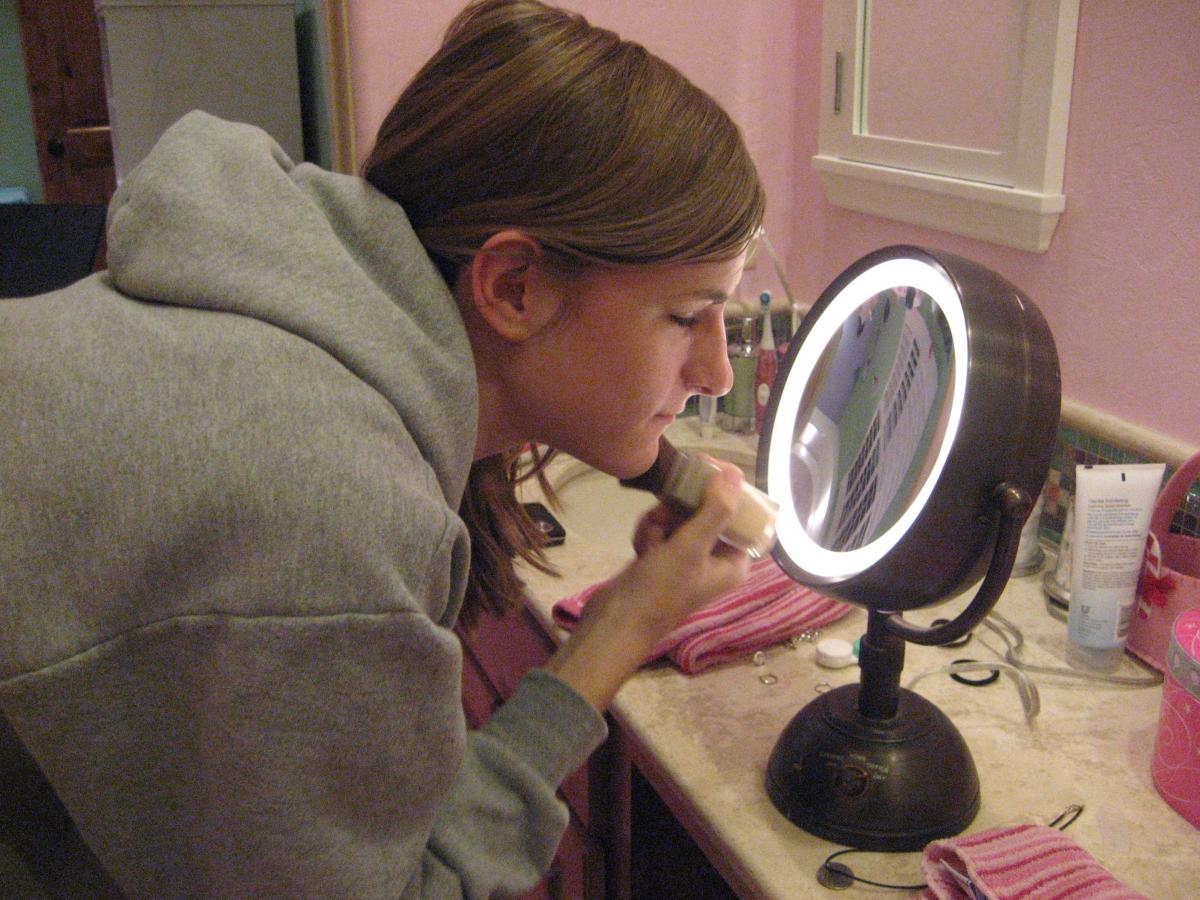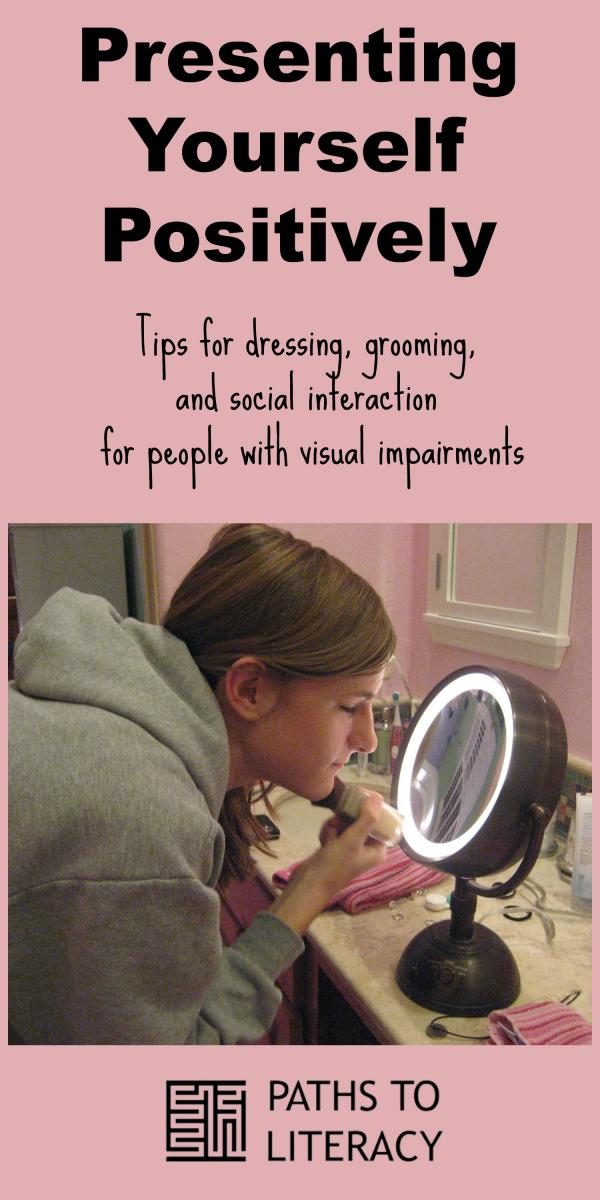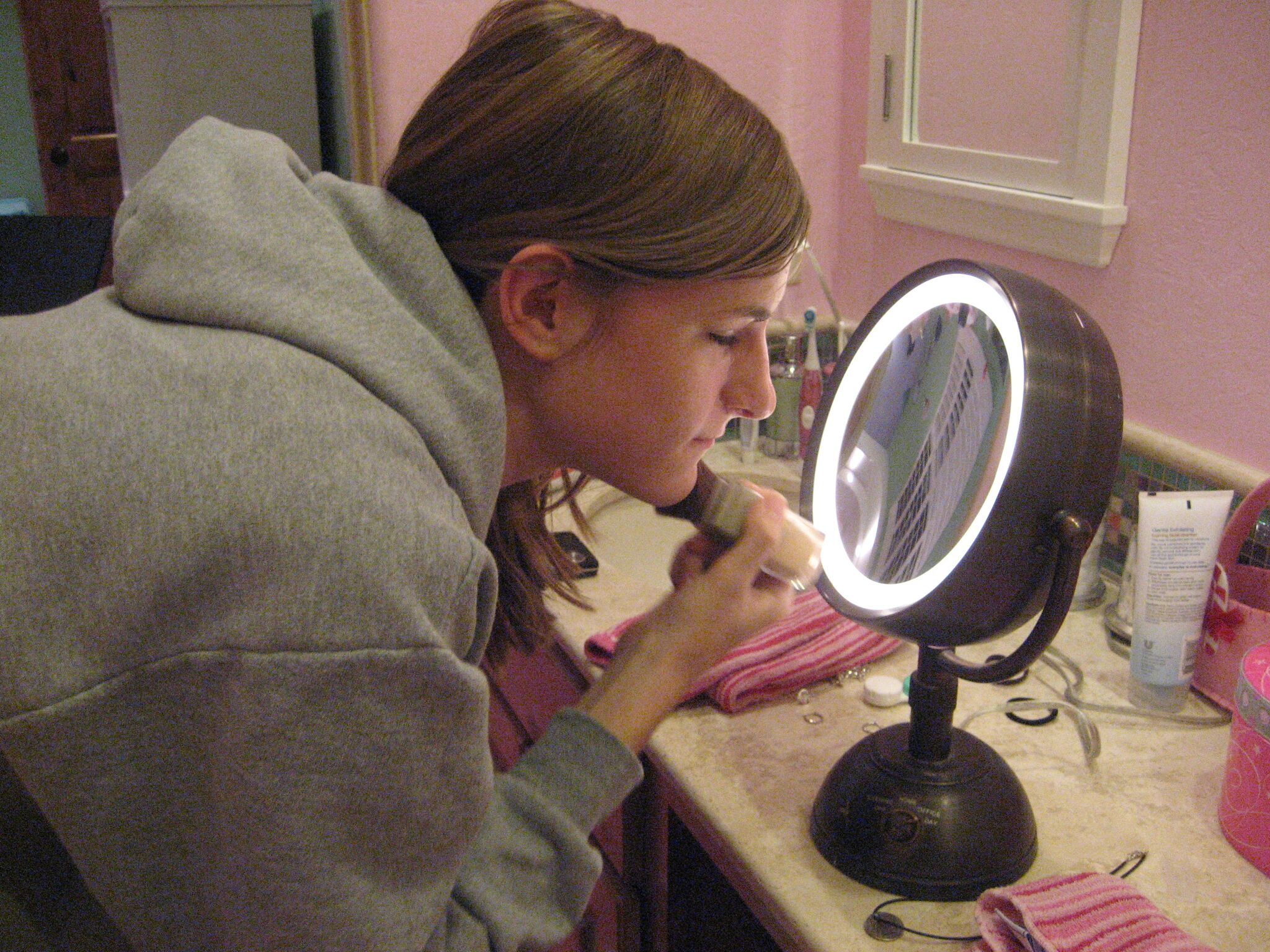 The expression “put your best foot forward” takes on new meaning when one has a visual impairment. In our society people are quick to judge you by how you look and present yourself. It is important that a person who is visually impaired recognize this and plan for it by “putting their best foot forward” in making a positive impression on others. Making a positive impression is more than just dressing well or giving a firm handshake, rather it is the entire picture one is presenting each and every time that you interact with others whether in person, in writing, or over the phone or video conferencing. Through visual observation sighted people take in a lot of information about the person they encounter, and whether consciously or subconsciously, they make judgments about that person. When handwriting is sloppy, for example, the sighted person may think that any work the visually impaired person does is sloppy. Or, when the visually impaired person’s hair is unkempt the impression by the sighted person may be that he doesn’t know how to take care of his personal needs.
The expression “put your best foot forward” takes on new meaning when one has a visual impairment. In our society people are quick to judge you by how you look and present yourself. It is important that a person who is visually impaired recognize this and plan for it by “putting their best foot forward” in making a positive impression on others. Making a positive impression is more than just dressing well or giving a firm handshake, rather it is the entire picture one is presenting each and every time that you interact with others whether in person, in writing, or over the phone or video conferencing. Through visual observation sighted people take in a lot of information about the person they encounter, and whether consciously or subconsciously, they make judgments about that person. When handwriting is sloppy, for example, the sighted person may think that any work the visually impaired person does is sloppy. Or, when the visually impaired person’s hair is unkempt the impression by the sighted person may be that he doesn’t know how to take care of his personal needs.
Presenting yourself positively includes selecting the right clothing for the occasion and wearing it well, how you groom yourself, how you communicate with others be it using print, braille, and/or technology; and your social interactions. Few of us are drop-dead gorgeous; most of us are just average people in average bodies, but the way we choose to dress, groom and interact with others can be the difference between being perceived as a capable, competent person who is sought out by others and being perceived as someone who is not effective and is to be avoided.
If you are a parent, it’s never too early to start thinking about the image your child with a visual impairment is sharing with the world. If you’re the one with a visual impairment, it may be easy for you to think, “Well I don’t see them, so what does it matter?” It does matter how you present yourself. We’ve got some ideas for you about dressing, grooming, communicating, and social interaction; four essential elements to presenting a positive you!
A Note to Parents
Regardless of your child’s age and abilities, the image she presents to the world can impact not only today but her future. Many people have never met a visually impaired person before and so your child presents the image of what visual impairment is to them. When your child has multiple disabilities, this can present further challenges because of your child’s physical appearance, social interaction (or lack of) skills, mannerisms (behaviors such as rocking, hand flapping, eye poking, etc.) or verbalizations.
Candice, the mother of 15 year old Stephen, has some strong feelings about the importance of Stephen’s appearance. She shares, “By the time Stephen was four years old, it was obvious that other children were unsure of how to interact with him. He looked different with his eyes often closed and his hands often flapping by his face as he rocked from foot to foot, he didn’t talk, and he hadn’t yet learned to play with toys. As the social gap widened, I realized the importance of making sure he was dressed the same way boys his age were dressed and that even if he didn’t know how to play with a toy like the other boys, he needed to have the ‘right’ toys, so to speak.”
Candice went on to share about a time when Stephen was 8 and they were at a park. Stephen had on a t-shirt with an action figure on it that was popular at the time and an action figure toy that made sounds. A boy came up to her and commented, “Wow he has a toy I really want, but my mom says I can’t have it.” Candice encouraged the boy to ask Stephen to share the toy and then prompted Stephen to let the boy have a turn. As the boy rambled on about the action figures special powers, Stephen periodically would say “Yeah, yeah, yeah.” Though he wasn’t responding to what the boy was saying, the boy didn’t realize this so he continued the interaction. It was at this time that Candice truly recognized the boy never would have started the interaction if Stephen hadn’t been “appealing” to him because of how he dressed and the toy he had.
As a 15 year old, Stephen prefers the toys of preschoolers and has no concept of the latest musical groups or pro sports teams. Candice has become a keen observer of teenage boys in her community. She often buys him clothes that have the logos of various musical groups and sports teams she sees other boys wearing. Stephen has an iPod with music on it that he likes (typical of that listened to by a younger child), but she has also loaded music onto it that teens enjoy and she has added some games favored by boys Stephen’s age. She’s taught Stephen to say, “Check out my iPod” and to offer it to others as a way to begin a social interaction.
We’re not saying you need to go out and buy your child a new wardrobe or make sure she has the most expensive toys or gadgets. Rather the message Candice is sharing with you is the need for your child to not stand out more because of the way he or she dresses, the things she has with her or her social interaction skills. Start when your child is young by laying the foundation. Here are a few ideas to get you going.
- Even if your child can’t see who she is talking to, she needs to look in the direction of the person speaking, so that person is comfortable interacting with her. Beginning when your child is a toddler ,praise her when she looks at people and encourage her to do so when she doesn’t.
- Like Candice, take time to observe what other children who are your child’s age and gender are doing, wearing, and saying. Learn about the television shows they watch, movies they go see, games they play, and music they like. Incorporate this information into your child’s life in the same way Candice did for Stephen.
-
Pay attention to the websites, books, and social media children your child’s age are using. Even if your child is a non-reader or not reading at the level of others, help her to develop an awareness of how others her age take in and share information. She can have an Instagram account for example where the two of you share her experiences. Taking photos of her doing things she enjoys and posting those to social media together is a great way to start.
- Give your child realistic feedback about how she looks and acts. Share the positives you observe with her, such as how she smiled when she introduced herself to the new family who moved into the neighborhood, how the color green goes well with her hair, or that her fingernails are trimmed evenly. At the same time, let your child know if her hair isn’t brushed nicely, her shirt is stained, or her head was down as she talked with a classmate. Your child isn’t necessarily going to get this feedback from anyone else so it’s important you give it to her.
- Help your child develop a signature – whether this is a handwritten signature or a stamp she uses to add her signature to items, such as a greeting card to a family member, an invitation to her birthday party, or a note to her teacher about what she did over the weekend.
- Consider enrolling your child in an acting, dance, or modeling class. Classes such as these help young people gain a better understanding of their own body and body image. In addition they are a great venue to meet others. Acting classes, especially, will allow your child to work on building her verbal communication skills with others. Some communities have programs for children with disabilities so speak with your child’s teacher or other team members about programs that might be available in your community.
- Describe to your child what you are observing when it comes to the impressions you have of others. Let your child know that the hostess at the restaurant was dressed in a flattering outfit, looked you in the eye when you entered the restaurant and smiled at you. By hearing about your observations your child will become more aware of the need to put her best foot forward because people really are paying attention.
- At school speak with your child’s educational team about including goals on her Individual Education Plan (IEP) that focus on skills she’ll need to present herself positively. There’s more to school than just academics.
Be sure to read our suggestions about dressing, grooming and social interactions. Though written for a person who is visually impaired, the ideas within these pages are ones you can consider and implement with your own child as appropriate.
Clothing Selection and Organization
Hang out in the mall and listen to conversations and you’re bound to hear two young women talking about how a sweater or pair of shoes looks and how they perceive it will look on them. Presenting the “right” look for a specific situation takes some thought and planning. Rarely do you wear a dress to a friend’s house for a sleepover nor do you wear sweatpants to a job interview. Even when you pick out the “right” type of clothing, matching the colors, getting a style that looks good on you, and making sure the clothes are clean takes time and effort.
How do I know what to wear?
You may not see what other people are wearing, but they can see what you’re wearing so you’ll want to pick clothes that are “in” and don’t make you look out of place. You can ask your family or friends for input on what to wear. You can look at magazines or on the internet. If you can’t see the pictures, ask others to describe them for you. Take notes for yourself about what you learn so you can refer back to these. At the mall you can visit stores that people your age shop in and talk to salespeople about what others are buying.
What colors and styles look good on me?
Experimentation is something we all do to find out what colors and styles look good with our own body type. Input from others is going to be essential to finding out what works well for you. If someone gives you a compliment on your clothes, pay attention to what you have on so you know what outfit has been noticed. Neutral colors, blacks, whites, grays, browns can be a cornerstone of your wardrobe. Almost every color such as blue, green, yellow, red will work with a neutral color.
How do I know what colors go together?
If you can’t see colors, how do you know if the green striped shirt goes with the flowered pants? This is where a trusted person can really help you organize your outfit choices. You might want to take notes about what goes with what, so you’ll not need to remember it all. Some people will pin outfits together in the closet or fold them together in the drawer so everything is in one place and they know it matches. When you put your outfit in the laundry, you can use safety pins or other fasteners to keep it together. Some people write out a list and keep it in their bedroom so they can refer to it when making outfit choices.
How do I tell my clothing apart?
There are lots of ways to tell your clothing apart so find a method that works for you. Some people sew tags into the collars or waistbands of clothing. You can buy clothing tags from companies such as MaxiAids and Independent Living Aids. Companies such as these sell a variety of tags that have different shapes, colors and/or tactual markings on them. If you put all the triangles in the colors of your blue shirts and all the squares in the collars of your white shirts you’ll be well on your way to having a system to tell like items apart. You develop a system that works for you.
Other people have a system where they cut notches clothing tags. For example anything red may have a notch cut out of the right side of the tag and anything blue may have a triangle shape cut into the bottom of the tag. Yet others divide clothes by color within the closet or drawer so that all blue things are together, all white things are together etc.
Another option is to add braille tags to items. You might pin cards on the hangers of clothing items and then when they come out of the laundry put them back on the same hangers. The important thing is that you come up with a system that is functional for you. Be sure to take notes on your system so you can refer back to them if you forget.
What about stains?
Sighted people have stains on their clothing from time-to-time; it’s human nature. They can look down and see the splash of spaghetti sauce on their shirt. There are a lot of products on the market to remove stains. If you think you might have spilled something and can’t tell, assume you have and treat the garment for stains. You can also enlist the help of someone sighted to let you know if there is a stain on your clothing. Another option is to take your clothes to a laundry service or dry cleaner and have them professionally cleaned. You won’t want to do this for the sweatshirt and jeans you wear around the house, but this might be a viable option for your work clothes or going-out-on-a-date clothes.
We’ve given you a few pointers to getting started on having your clothes in order.
Grooming
We’re sure you know how to take a bath or shower, brush your teeth and all that personal hygiene stuff, so what we’re going to focus on here is the importance of having a presentable appearance, tools to assist you with getting your grooming done efficiently, shaving and for the ladies putting on makeup.
Why does it matter how my hair looks or if my nails are trimmed?
Since you more than likely can’t tell if someone else has neatly trimmed nails or if they have lint on their pants, why does it matter if you do? Well it does, and it more than likely matters more for you than it does for the other person. Why? The truth is because you have a disability, people tend to look at you more and scrutinize everything you do. We’re not saying all people in all situations, but especially when meeting new people, dating, or working at a job, people do look and they do judge.
You want people to judge you on your strengths, your great personality, your ability to get the job done, or your knowledge of a subject. Your personal appearance can detract from this and ultimately could impact your ability to make friends, get a job, or keep a job. So, how you present yourself DOES matter!
What tools can assist me when it comes to grooming?
If you have some usable vision lighting is a must. You have to be able to see how you look and the better the light the more you’ll see in most cases. Consider changing the light bulb in your bathroom or bedroom to one that will allow you to yourself as clearly as possible. Think about using a full spectrum light or a light bulb that mimics natural light.
Also think about the use of magnification, be it a stand magnifier or a magnifying mirror. Some people will polish or trim their nails under a closed circuit television. Combining looking at and feeling the smoothness of each nail will help you get them looking even.
A lint brush is a must, especially if you own a pet, so get in the habit of using this tool to get excess lint, pet hair, etc. off of your clothing. Use a systematic method where you overlap strokes so that you don’t miss a spot. Also consider using the lint brush before you put on the clothing and then again once you have it on.
Wrinkles can take away from your appearance. Learn to iron and do so systematically. If you’re not a fan of ironing, then buy clothes that don’t wrinkle easily, hang clothes up in the bathroom nearby the shower so that the steam from the shower takes the wrinkles out, or put the clothing item in the dryer on fluff right before you plan to wear it.
When do I seek out a professional?
If your finances allow, consider visiting a professional for assistance with grooming. As part of getting your hair cut and styled, ask for an extended appointment (and be prepared to pay for the time) so that the hair technician can show you how care for your hair, use the products he or she recommends, and allow you to practice styling your hair with their input. Men can ask a barber to trim their mustache or beard and help them determine the best length for them to keep these. Woman can schedule time with makeup technicians and nail technicians to get one-on-one instruction in how to apply products. There are many fully sighted people who take advantage of getting input from these professionals, so why shouldn’t you? Be sure the individual understands what you can and cannot see. Ask him or her to let you apply the makeup, hair product, or use the beard trimmer so you can make sure you really have the directions down and can carry things out at home.
What are my options when it comes to shaving?
An electric razor is a great option when it comes to shaving. You’re not going to draw blood when you use an electric razor! Regardless of what type of razor you use be systematic and overlap your strokes. Use your hand to feel the area you have shaved to make sure it is clean and smooth.
How do I know what colors of makeup to use and if I’ve put them on correctly?
Makeup is very individualized. What works for one woman won’t work for another. To select your makeup, you’re going to need to enlist the help of someone sighted: a friend, family member, or makeup technician in the store. Show the person some samples of clothing you wear, so they can help you in selecting makeup that will go with your color pallet. You may want to get two sets of makeup: one for every day and one for “going out” or special occasions. You can keep each set in a separate bag or box so you don’t mix things up. Consider labeling the containers with braille, large print or tactile markings, so you know which eye shadow is which color.
When it comes to putting on the makeup, you need someone who is going to be honest with you and let you know if you have the right “look”. You don’t want lots of blush on your left cheek and hardly any on your right cheek. Be prepared to practice applying makeup as it takes practice to get the feel for how it is done. If you have some usable vision, consider having a magnifying mirror to look at yourself in as you apply the makeup.
Using a systematic approach to makeup application is a must if you have a visual impairment. For example, when putting on your foundation, always start at your forehead, then left cheek, then right cheek, then chin. If you go in the same order each time you won’t end up with two applications on your left cheek. Try counting, for example 3 strokes of blush on each cheek. Use landmarks on your face to help you orient. Feel for your cheekbone and use this as the starting place for applying the blush. Be gentle, if you feel you’ve put on too much lipstick take a damp washcloth or cotton ball and gently wipe at the edges of your lips. You want to be careful not to smear the foundation.
Keep in mind that as you get older the amount of makeup and the color pallet you use is going to change. Fashion also changes over time. Hence it is a good idea each year on your birthday to review your makeup choices with someone you trust who is sighted. They can give you honest observations about what they are seeing you do in comparison to what other women your age are doing.
Social Interaction Skills
As you think about the way you are presenting yourself to others, it’s impossible to not consider your social interaction skills. Do you hold your head up? Do you look in the direction of the person speaking? Do you stay on the topic of the conversation? Do you have a firm handshake? Do you smile at the right time? Things such as these impact how others perceive you and your overall appearance.
When you interact with others there is your verbal interaction, what you say and the tone of your voice, pitch, loudness etc. and there is what is called nonverbal behaviors. Nonverbal behaviors are your physical actions and how these are “read” by others. For example your smile or frown is a nonverbal behavior, nodding your head to signify “yes” or “no” is considered nonverbal behavior as is crossing your arms across your chest to let someone know you are bored or impatient. Sighted people get a lot of information from observing the nonverbal behavior of others. When you can’t see this behavior it can make it a challenge for you to read the signals others are giving. At the same time you may be giving out the wrong information about yourself through your nonverbal behavior. You might smile when someone is telling you sad news and you may not even realize you have a smile on your face. Or the way you are slouching in your chair may give the message that you are not interested in anyone talking to you when in reality you would love to be included in the conversation.
You need to get honest feedback from those you trust about your social presence in different situations. This is how Carmen approached getting some feedback from his friend Doug.
Carmen and Doug were in Doug’s car headed to the food court at the mall where they were meeting their friend Marco. Marco had texted them that he was at the pizza place with Greg, a new guy at school. Carmen had never met Greg before. Before they arrived he told Doug that he always hated meeting new people because they got freaked out when they saw his cane. Doug pointed out that sometimes people freaked out because Carmen didn’t look at them and his voice sometimes sounds funny when he is nervous. Rather than getting offended, Carmen told Doug that he’d try to look at Marco and pay attention to how he sounded. After the guys had pizza and Carmen and Doug were headed home, Carmen asked Doug to give him some honest feedback about if he was looking at Marco and if his voice sounded ok.
Like Carmen you can get feedback from others…let them know you really want to hear their honest impressions. If you don’t feel comfortable doing what Carmen did, consider audio taping and/or video taping yourself as you interact with someone and then reviewing it later to judge what you did well and what you can improve on. Of course you want to be respectful of the other people, so ask if it is okay for you to tape the interaction or, if you don’t ask, be sure only you listen/view the audio/video and then delete it.
Taking a drama or public speaking class or joining a club with this type of focus is another way you can work on your social interaction skills. In these types of classes or clubs people talk about how to present themselves or their character. You’ll pick up some good pointers on how both verbal and nonverbal language is read by others.

This article was originally posted on the BrailleSC website, which was funded by a grant from the US Department of Education with support from the University of South Carolina Upstate and The Maryland Institute for Technology in the Humanities.




